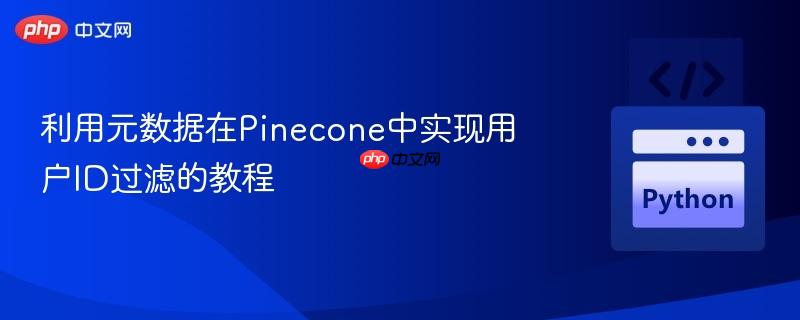
本文详细介绍了如何在多租户rag应用中,利用pinecone向量数据库的元数据过滤功能,高效且安全地隔离不同用户的向量数据。通过在向量嵌入时附加用户id作为元数据,并在检索时应用精确过滤,可以避免创建昂贵的独立索引,实现资源共享和数据隔离的平衡,从而优化系统性能和成本。
在构建多用户或多租户的检索增强生成(RAG)系统时,一个常见且关键的需求是如何在共享的向量数据库中,高效且安全地隔离不同用户的数据。例如,在一个PDF阅读器应用中,每个用户上传的文档都应仅供其本人查询。直接为每个用户创建独立的Pinecone索引虽然能实现数据隔离,但随着用户数量的增长,这将带来高昂的成本和管理复杂性。本文将深入探讨如何利用Pinecone的元数据过滤功能,以一种更经济、更优雅的方式解决这一挑战。
Pinecone允许在存储向量时,为每个向量附加一组键值对形式的元数据。这些元数据可以在查询时作为过滤条件,精确地筛选出符合特定条件的向量。这是实现多租户数据隔离的理想方案,因为它允许所有用户的数据存储在同一个索引中,但通过元数据确保查询结果仅限于当前用户的数据。
在将文档内容转换为向量并上传到Pinecone时,需要将用户的唯一标识符(例如user_id)作为元数据一并存储。
示例:上传向量时附加元数据
from pinecone import Pinecone, Index
from langchain_openai import OpenAIEmbeddings
from langchain_community.vectorstores import Pinecone as LangchainPinecone
import os
# 初始化Pinecone客户端和嵌入模型
api_key = os.getenv("PINECONE_API_KEY")
environment = os.getenv("PINECONE_ENVIRONMENT")
index_name = os.getenv("PINECONE_INDEX")
pinecone_client = Pinecone(api_key=api_key, environment=environment)
embeddings = OpenAIEmbeddings(openai_api_key=os.getenv("OPENAI_API_KEY"))
# 假设这是您要嵌入的文档和对应的用户ID
documents_for_user1 = [
("This is a document for user 1.", {"source": "user_document", "user_id": 1}),
("Another piece of text from user 1.", {"source": "user_document", "user_id": 1})
]
documents_for_user2 = [
("User 2's specific information.", {"source": "user_document", "user_id": 2}),
("A different document for user 2.", {"source": "user_document", "user_id": 2})
]
# 获取或创建Pinecone索引
if index_name not in pinecone_client.list_indexes():
pinecone_client.create_index(
name=index_name,
dimension=embeddings.client.dimensions, # 确保维度匹配您的嵌入模型
metric='cosine'
)
pinecone_index = pinecone_client.Index(index_name)
# 批量嵌入并上传向量,包含user_id元数据
def upsert_vectors_with_metadata(index: Index, texts_and_metadatas: list, embeddings_model, batch_size=32):
for i in range(0, len(texts_and_metadatas), batch_size):
batch = texts_and_metadatas[i:i+batch_size]
texts = [item[0] for item in batch]
metadatas = [item[1] for item in batch]
# 生成嵌入
embeds = embeddings_model.embed_documents(texts)
# 准备upsert数据
# Pinecone的upsert方法需要 (id, vector, metadata) 格式
# 这里我们简化处理,假设id是递增的
vectors_to_upsert = []
for j, (text, metadata) in enumerate(batch):
# 实际应用中,id应该是一个唯一且持久的标识符
vector_id = f"doc_{metadata['user_id']}_{i+j}"
vectors_to_upsert.append((vector_id, embeds[j], metadata))
index.upsert(vectors=vectors_to_upsert)
print(f"Upserted {len(texts_and_metadatas)} vectors to index '{index_name}'.")
# 示例调用
# upsert_vectors_with_metadata(pinecone_index, documents_for_user1, embeddings)
# upsert_vectors_with_metadata(pinecone_index, documents_for_user2, embeddings)注意: 上述代码片段展示了如何手动进行upsert。在实际使用Langchain的Pinecone向量存储时,当您使用from_documents或add_documents方法时,可以将元数据作为参数传递,Langchain会自动处理与Pinecone的交互。

采用HttpClient向服务器端action请求数据,当然调用服务器端方法获取数据并不止这一种。WebService也可以为我们提供所需数据,那么什么是webService呢?,它是一种基于SAOP协议的远程调用标准,通过webservice可以将不同操作系统平台,不同语言,不同技术整合到一起。 实现Android与服务器端数据交互,我们在PC机器java客户端中,需要一些库,比如XFire,Axis2,CXF等等来支持访问WebService,但是这些库并不适合我们资源有限的android手机客户端,
 0
0

当用户发起查询时,您需要从当前用户的会话或请求中获取其user_id,并将其作为过滤条件传递给Pinecone检索器。
示例:在Langchain的ConversationalRetrievalChain中应用用户ID过滤
from flask import Flask, request, jsonify, session
import os
from langchain_openai import ChatOpenAI
from langchain.memory import ConversationBufferWindowMemory
from langchain.chains import ConversationalRetrievalChain
from langchain_core.prompts import PromptTemplate
from langchain_community.vectorstores import Pinecone as LangchainPinecone
from pinecone import Pinecone, Index
app = Flask(__name__)
app.secret_key = os.getenv("FLASK_SECRET_KEY", "supersecretkey") # 用于会话管理
# 初始化Pinecone客户端和嵌入模型
pinecone_api_key = os.getenv("PINECONE_API_KEY")
pinecone_environment = os.getenv("PINECONE_ENVIRONMENT")
openai_api_key = os.getenv("OPENAI_API_KEY")
index_name = os.getenv("PINECONE_INDEX")
text_field = "text" # 假设您的文本内容存储在元数据的'text'字段中
pinecone_client = Pinecone(api_api_key=pinecone_api_key, environment=pinecone_environment)
embeddings = OpenAIEmbeddings(openai_api_key=openai_api_key)
# 获取Pinecone索引实例
# 确保索引已经存在并包含数据
pinecone_index_instance = pinecone_client.Index(index_name)
# 使用Langchain的Pinecone集成创建vectorstore
vectorstore = LangchainPinecone(
index=pinecone_index_instance,
embedding=embeddings,
text_key=text_field # 指定存储原始文本的元数据字段
)
# 假设这些函数用于获取用户特定的配置
def get_bot_temperature(user_id):
# 根据user_id返回不同的温度,或默认值
return 0.7
def get_custom_prompt(user_id):
# 根据user_id返回不同的自定义提示,或默认值
return "You are a helpful AI assistant. Answer the question based on the provided context."
@app.route('/<int:user_id>/chat', methods=['POST'])
def chat(user_id):
user_message = request.form.get('message')
if not user_message:
return jsonify({"error": "Message is required"}), 400
# 从会话中加载对话历史
# 注意:为了每个用户隔离,会话键应包含user_id
conversation_history_key = f'conversation_history_{user_id}'
conversation_history = session.get(conversation_history_key, [])
bot_temperature = get_bot_temperature(user_id)
custom_prompt = get_custom_prompt(user_id)
llm = ChatOpenAI(
openai_api_key=openai_api_key,
model_name='gpt-3.5-turbo',
temperature=bot_temperature
)
prompt_template = f"""
{custom_prompt}
CONTEXT: {{context}}
QUESTION: {{question}}"""
TEST_PROMPT = PromptTemplate(input_variables=["context", "question"], template=prompt_template)
memory = ConversationBufferWindowMemory(memory_key="chat_history", return_messages=True, k=8)
# 关键部分:在as_retriever中应用filter
# Pinecone的过滤语法是字典形式,这里使用'$eq'操作符表示“等于”
retriever = vectorstore.as_retriever(
search_kwargs={
'filter': {'user_id': user_id} # 精确匹配当前用户的user_id
}
)
conversation_chain = ConversationalRetrievalChain.from_llm(
llm=llm,
retriever=retriever, # 使用带有过滤器的retriever
memory=memory,
combine_docs_chain_kwargs={"prompt": TEST_PROMPT},
)
response = conversation_chain.run({'question': user_message})
# 保存用户消息和机器人响应到会话
conversation_history.append({'input': user_message, 'output': response})
session[conversation_history_key] = conversation_history
return jsonify(response=response)
# if __name__ == '__main__':
# # 仅用于开发测试,生产环境应使用WSGI服务器
# app.run(debug=True)代码解析:
通过在Pinecone中利用元数据过滤,我们能够构建一个高效、可扩展且成本效益高的多租户RAG系统。这种方法避免了为每个用户创建独立索引的复杂性和高成本,同时确保了数据隔离和查询的准确性。在设计多用户应用时,将用户ID等关键标识符作为元数据存储并应用于检索过滤,是实现数据隔离和资源共享的强大策略。
以上就是利用元数据在Pinecone中实现用户ID过滤的教程的详细内容,更多请关注php中文网其它相关文章!

每个人都需要一台速度更快、更稳定的 PC。随着时间的推移,垃圾文件、旧注册表数据和不必要的后台进程会占用资源并降低性能。幸运的是,许多工具可以让 Windows 保持平稳运行。




Copyright 2014-2025 https://www.php.cn/ All Rights Reserved | php.cn | 湘ICP备2023035733号